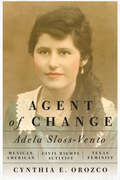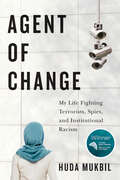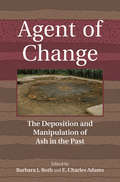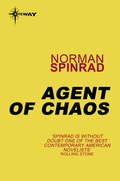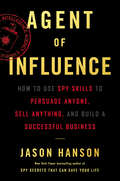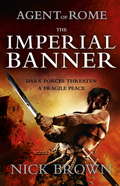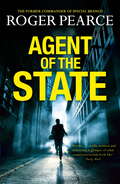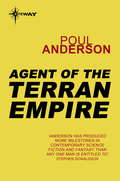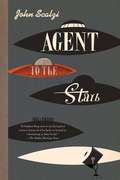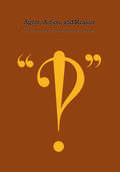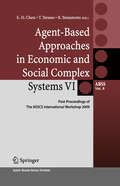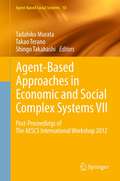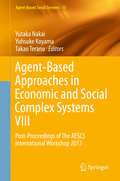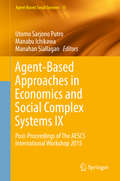- Table View
- List View
Agent of Change: Adela Sloss-Vento
by Cynthia E. OrozcoThe essayist Adela Sloss-Vento (1901–1998) was a powerhouse of activism in South Texas&’s Lower Rio Grande Valley throughout the Mexican American civil rights movement beginning in 1920 and the subsequent Chicano movement of the 1960s and 1970s. At last presenting the full story of Sloss-Vento&’s achievements, Agent of Change revives a forgotten history of a major female Latina leader. Bringing to light the economic and political transformations that swept through South Texas in the 1920s as ranching declined and agribusiness proliferated, Cynthia E. Orozco situates Sloss-Vento&’s early years within the context of the Jim Crow/Juan Crow era. Recounting Sloss-Vento&’s rise to prominence as a public intellectual, Orozco highlights a partnership with Alonso S. Perales, the principal founder of the League of United Latin American Citizens. Agent of Change explores such contradictions as Sloss-Vento&’s tolerance of LULAC&’s gender-segregated chapters, even though the activist was an outspoken critic of male privilege in the home and a decidedly progressive wife and mother. Inspiring and illuminating, this is a complete portrait of a savvy, brazen critic who demanded reform on both sides of the US-Mexico border.
Agent of Change: My Life Fighting Terrorists, Spies, and Institutional Racism
by Huda MukbilIn Agent of Change Huda Mukbil takes us behind the curtain of a leading spy agency during a fraught time, recounting her experiences as an intelligence officer for the Canadian Security Intelligence Service. Mukbil was the first Black Arab-Canadian Muslim woman to join CSIS and was at the forefront of the fight against terrorism after 9/11.Mukbil’s mastery of four languages quickly made her a counterterrorism expert and a uniquely valuable asset to the organization. But as she worked with colleagues to confront new international threats, she also struggled for acceptance and recognition at the agency. Following the American-led invasion of Iraq in 2003 and the rise of homegrown extremism, Mukbil was framed as an inside threat. Determined to prove her loyalty, while equally concerned about the surveillance and profiling of Muslims and revelations of Western agencies’ torture and torture by proxy, Mukbil started to question CSIS’s fluctuating ethical stance in relation to its mandate. Her stellar work on a secondment to MI5, the British Security Service, earned commendation; this shielded her, but only temporarily, from the hostile workplace culture at CSIS. Ultimately, Mukbil and a group of colleagues went public about the pervasive institutional discrimination undermining CSIS and national security from within.Mukbil’s expertise in international security and her commitment to workplace transparency drove important changes at CSIS. Dazzlingly written, her account is an eye-opener for anyone wanting to understand how racism, misogyny, and Islamophobia undermine not only individuals, but institutions and the national interest – and how addressing this openly can tackle populism and misinformation.
Agent of Change: The Deposition and Manipulation of Ash in the Past
by Barbara J. Roth E. Charles AdamsAsh is an important and yet understudied aspect of ritual deposition in the archaeological record of North America. Ash has been found in a wide variety of contexts across many regions and often it is associated with rare or unusual objects or in contexts that suggest its use in the transition or transformation of houses and ritual features. Drawn from across the U.S. and Mesoamerica, the chapters in this volume explore the use, meanings, and cross-cultural patterns present in the use of ash. and highlight the importance of ash in ritual closure, social memory, and cultural transformation.
Agent of Change: The Deposition and Manipulation of Ash in the Past
by Barbara J. Roth and E. Charles AdamsAsh is an important and yet understudied aspect of ritual deposition in the archaeological record of North America. Ash has been found in a wide variety of contexts across many regions and often it is associated with rare or unusual objects or in contexts that suggest its use in the transition or transformation of houses and ritual features. Drawn from across the U.S. and Mesoamerica, the chapters in this volume explore the use, meanings, and cross-cultural patterns present in the use of ash. and highlight the importance of ash in ritual closure, social memory, and cultural transformation.
Agent of Chaos
by Norman SpinradThe Great Tyrant rules the solar system with absolute terror. Only one man dares to fight back.The time is the 24th century. Humankind populates the entire solar system from icy Pluto to boiling Mercury. Great domed cities, humming factories, hordes of workers, all feed the power of the dictatorship that controls all life. Only a small group among the cowed population dares rebel in a struggle that pits democracy against tyranny.But there is a third force at work as well. A mysterious band of assassins whose final solution to the problem of humanity's fate is as terrifying as it is irresistible - one of them is known as the AGENT OF CHAOS.
Agent of Chaos
by Norman SpinradThe Great Tyrant rules the solar system with absolute terror. Only one man dares to fight back. The time is the 24th century. Humankind populates the entire solar system from icy Pluto to boiling Mercury. Great domed cities, humming factories, hordes of workers, all feed the power of the dictatorship that controls all life. Only a small group among the cowed population dares rebel in a struggle that pits democracy against tyranny. But there is a third force at work as well. A mysterious band of assassins whose final solution to the problem of humanity's fate is as terrifying as it is irresistibleone of them is known as the AGENT OF CHAOS.
Agent of Chaos (The X-Files Origins #1)
by Kami GarciaHow did Fox Mulder become a believer?Read this dark thriller to find out why millions of people became obsessed with The X-Files. In the spring of 1979, seventeen-year-old Fox Mulder has bigger problems than applying for college. Five years ago, his younger sister disappeared from their home and was never heard from again. Mulder blames himself, and his mother blames his father, who has retreated into his top-secret work for the State Department. In Fox’s senior year, his dad has moved him to Washington, DC—away from his friends on Martha’s Vineyard. While Mulder doesn’t mind the fresh start and not being known as “that kid with the missing sister,” he’s still obsessed with finding Samantha. So when a local boy turns up dead and another child is abducted, Mulder can’t stop himself from getting involved. Could there be a link to his sister’s case? As he uncovers the truth, Mulder and his friends find themselves on the trail of a serial killer. Sucked into a world where conspiracies, the occult, and madness overlap, Fox Mulder starts to believe.
Agent of Influence
by David AaronA young Wall Street dealmaker named Jayson Lyman gets an assignment. News/Worldweek, the media conglomerate that controls many of the nation's top newspapers, magazines, and TV stations, has been targeted for a takeover by French magnate Marcel Bresson. Beating him should be a snap, says Lyman; no one wants a foreigner running the American press. I hope you're wrong, says his boss--because he's your client. The more Lyman learns, the more shadowy Bresson seems--no fixed address, no financial partners, blanks in his past. Lyman is baffled by him--until he meets Heidi Bruce, deputy director of the Senate Intelligence Committee, who is trying to convince the US government that the Soviets are using advanced intelligence technology to manipulate Western financial markets--and thereby Western governments. With the help of Sean Gordon, maverick CIA agent and Heidi's former lover, they race across Europe, following a trail of deception and death in search of Bresson's true identity, alarming not only the KGB but the CIA and the French Deuxieme Bureau. Convinced that America's biggest press empire may well end up under Soviet control--but unable to convince anyone else but Heidi and Sean--Lyman must choose between the deal of a lifetime and his country's future. Despite his rivalry with Gordon, and with Wall Street and the intelligence services of East and West arrayed against him, he joins with the two others in a desperate plan to stop the Bresson takeover--but even they cannot predict the wild chain of events they will set in motion. As Agent of Influence speeds to its climax, we are swept into a world of exceptional drama and treachery--one that is more fact than fiction.
Agent of Influence: How to Use Spy Skills to Persuade Anyone, Sell Anything, and Build a Successful Business
by Jason HansonA practical guide to bolstering your business strategies with proven spy techniques, from a New York Times–bestselling author.“Entertaining. . . . There is serious information here that could be used beyond the business setting.”—BooklistCommon wisdom has held that the most successful businesspeople in the world possess fancy degrees and unlimited access to wealth and connections. But the truth is that education and connections don’t matter if one doesn’t have the skills with which to use them. Spies, however, have spent their careers learning how to successfully persuade others. In fact, intelligence officers are among the best salesmen in the world.And the product they sell? Loyalty to the United States.Whether we realize it or not, each one of us is a salesman. Every day, we sell our talents, values, and ideas to colleagues, friends, and even our partners. At the office, we maneuver in code to receive promotions, higher salaries, and recognition.In Agent of Influence, former CIA officer and New York Times bestselling author Jason Hanson pulls back the curtain on how anyone can use spy tactics to become a more successful and business-conscious individual. Hanson will teach us how to spot the perfect business opportunity and make money by using the SADR cycle of “spotting,” “assessing,” “developing,” and “recruiting.” He will zero in on skills such as alliance building, matching and mirroring, and building bridges between people, showing us how we can more confidently maneuver in our professional and personal lives.Great for fans of Jocko Willink’s Extreme Ownership and Chris Voss’s Never Split the Difference.“Hanson has written a must-read manual on how to be a better businessperson. This book shows you what games are being played below the surface and gives you the CIA-tested methods on how to win them every time. Read this book and learn from one of the best.”—Oren Klaff, author of Pitch Anything
Agent of Peril
by Don PendletonCOURSE OF ACTIONWithout warning, three U.S.-made tanks swoop down on an Israeli settlement with cannons blazing. When the attack is over, hundreds are dead. Mack Bolan's hard probe reveals that the tanks were missing from a U.S.-to-Egypt military aid package. Bolan's mission takes him to Cairo to find out who is selling American weapons to terrorists. But the enemy is organized and deadly, anticipating his arrival. He races across Egypt and Lebanon, facing highly trained commandos, Hezbollah hitmen, even a Syrian armored platoon.It all leads to an ancient copper mine, a squadron of nerve-gas bearing drones, and a countdown to the start of a bloody war between Egypt
Agent of Rome: Agent of Rome 2
by Nick Brown272 AD The Roman Emperor Aurelian has defeated Queen Zenobia and crushed the Palmyran revolt. Faridun's Banner, hallowed battle standard of the Persian Empire, has fallen into Roman hands and is to be returned to the Persians as part of a historic peace treaty. But on the eve of the signing the banner goes missing. Recalled to Syria, imperial agent Cassius Corbulo is charged with recovering the flag. Accompanied by his faithful servant Simo and ex-gladiator bodyguard Indavara, Cassius must journey across the dangerous wastes of Syria to the equally perilous streets of Antioch. He and his companions face ruthless brigands, mysterious cults, merciless assassins and intrigue at every turn.
Agent of Vega and Other Stories
by James H. SchmitzPreviously appearing in separate publications, these stories of the Galaxy are now in a unitary publication. After the Galactic Empire crumbled, the Vegan Confederacy was too weak to survive, yet it prospered because of its secret weapon--telepathy. Not all of the Agents of Vega were human, but all were the most powerful telepaths in the Galaxy.
Agent of the State: A groundbreaking new thriller by the former commander of special branch
by Roger PearceA suspected terrorist is frisked for explosives on the Embankment. Operators do this so skilfully he remains completely unaware... In New Scotland Yard a new brand of manager fails to deal with escalating threats - 'aggressive indecision' is what Detective Chief Inspector John Kerr calls it... He discovers that cocaine-fuelled sex parties in Knightsbridge are pulling in businessmen, Russian diplomats and senior members of the British government... When Kerr's investigations are blocked by his bosses in Scotland Yard, he decides to go it alone and begins to expose a cover-up that extends to all levels of the British Establishment. Agent of the State is the first novel by Roger Pearce, a former Special Branch officer at New Scotland Yard who rose to become its Commander and a key player in Whitehall's intelligence network. It is an authentic account of the way the British intelligence services work at all levels and of the hypocrisy of the British establishment.
Agent of the State: A groundbreaking new thriller by the former commander of special branch
by Roger PearceA suspected terrorist is frisked for explosives on the Embankment. Operators do this so skilfully he remains completely unaware... In New Scotland Yard a new brand of manager fails to deal with escalating threats - 'aggressive indecision' is what Detective Chief Inspector John Kerr calls it... He discovers that cocaine-fuelled sex parties in Knightsbridge are pulling in businessmen, Russian diplomats and senior members of the British government... When Kerr's investigations are blocked by his bosses in Scotland Yard, he decides to go it alone and begins to expose a cover-up that extends to all levels of the British Establishment. Agent of the State is the first novel by Roger Pearce, a former Special Branch officer at New Scotland Yard who rose to become its Commander and a key player in Whitehall's intelligence network. It is an authentic account of the way the British intelligence services work at all levels and of the hypocrisy of the British establishment.
Agent of the Terran Empire: A Flandry Book
by Poul Anderson"If it pleased Ruethen of the Long Hand to give a feast and ball at the Crystal Moon for his enemies. He knew they must come. Pride of race had slipped from Terra, while the need to appear well-bred and sophisticated had waxed correspondingly. The fact that spaceships prowled and fought, fifty light-years beyond Antares, made it all the more impossible a gaucherie to refuse an invitation from the Mersian representative. Besides, one could feel delightfully wicked and ever so delicately in danger."It is the common fate of empires to grow old and jaded: Rome, Byzantium, Britain, America, and so on to the Empire of Terra itself, each has near the end succumbed to the same weary "sophistication" that allows a warlord of Merseia to make a mock of a race whose star-conquering ancestors found the Merseians a race of pre-technic barbarians huddled in stone piles - and saved them from extinction. Flandry himself has come to understand that there is no more point to all his victories than that a few trillion of his fellow creatures may live out their lives before the coming of the Long Night of galactic barbarism. That he will not have shortened that coming Dark Age one bit - only postponed it. That the barbarians always win in the end, and are always followed by a new round of civilisation.
Agent of the Unknown
by Margaret St ClairDon Haig had been content to lie around and drink in the synthetic beauty of the pleasure planetoid Fyon, until a woman came into his life. A woman more beautiful and more perfect than any other female in the galaxy. A woman who brought about a curious change in Don.For she was a pocket-sized foll - a very strange and miraculous puppet who shed constant tears and held powers that Don never even dreamed of.But what Don did know was that dangerous alien forces were swiftly focusing on him and his living puppet - and that he had to discover the doll's super-scientific secret before his own life was smashed into atoms.
Agent to the Rescue
by Lisa ChildsA bride on the run...and a killer on the prowl...hen FBI special agent Dalton Reyes discovers an amnesiatic injured bride in the trunk of a car, his protective instincts kick into high gear. Who is this mysterious redhead? And why is someone going to such great lengths to kill her? When a man claiming to be her fiancé steps forward, Dalton can't ignore his jealously...and his fear that that her betrothed isn't who he seems. But as Elizabeth-his beautiful charge-faces the dark truth of her past, Dalton must keep her and her two-year-old adopted daughter safe from the evil forces determined to reclaim them both...
Agent to the Stars
by John ScalziThe space-faring Yherajk have come to Earth to meet us and to begin humanity's first interstellar friendship. There's just one problem: They're hideously ugly and they smell like rotting fish. So getting humanity's trust is a challenge. The Yherajk need someone who can help them close the deal. Enter Thomas Stein, who knows something about closing deals. He's one of Hollywood's hottest young agents. But although Stein may have just concluded the biggest deal of his career, it's quite another thing to negotiate for an entire alien race. To earn his percentage this time, he's going to need all the smarts, skills, and wits he can muster.
Agent's Mountain Rescue (Wyoming Nights #2)
by Jennifer D. BokalHe didn’t want her helpBut she’s the one he desperately needs…Operative Liam Alexander is a tracker, used to working solo, even in treacherous mountain terrain. He only agrees to partner with child psychologist Holly Jacobs to stop a deadly serial killer. When Liam’s daughter is abducted by the twisted murderer, what begins as a working relationship turns into so much more. But can Liam rescue his baby girl without sacrificing the family he’s grown to love?From Harlequin Romantic Suspense: Danger. Passion. Drama.Wyoming Nights
Agent's Wyoming Mission (Wyoming Nights #Book 3)
by Jennifer D. BokalA new murder to solveAn old enemy on the looseHas a jailed serial killer somehow struck again? Agent Luis Martinez enlists his former friend Sheriff Julia McCloud to investigate, even though this new partnership unsettles them both. Personally, Luis feels the need to protect his PTSD-afflicted partner. Most of all, he realizes the undeniable attraction growing between them threatens their case…as much as the serial killer taunting and targeting them.From Harlequin Romantic Suspense: Danger. Passion. Drama.Feel the excitement in these uplifting romances, part of the Wyoming Nights series:Book 1: Under the Agent’s Protection by Jennifer D. BokalBook 2: Agent’s Mountain Rescue by Jennifer D. Bokal
Agent, Action, and Reason
by R. N. Bronaugh Robert W. Binkley Ausonio MarrasThis volume contains the papers and commentaries presented at the fourth philosophy colloquium at the University of Western Ontario in November 1968. The papers examine, from different points of view, the central problems in the philosophy of action. They include: "Agency" by Donald Davidson with comments by James Cornman; "On the Logic on International Action" by Roderick Chisholm with comments by Bruce Aune and a reply by Roderick Chisholm; "Wanting: Some Pitfalls" by R.M. Hare with comments by David Gauthier and D.F. Pears; "Two Problems about Reasons for Actions" by D.F. Pears with comments by Irving Thalberg. Also included is an extensive bibliography of recent work in the philosophy of action. The contributors are all well known for their work in this branch of philosophy; their papers present a cross section of the best work being done in the area at the present time.
Agent-Based Approaches in Economic and Social Complex Systems VI: Post-Proceedings of The AESCS International Workshop 2009 (Agent-Based Social Systems #8)
by Takao Terano Ryuichi Yamamoto Shu-Heng ChenAgent-based modeling/simulation is an emergent approach to the analysis of social and economic systems. It provides a bottom-up experimental method to be applied to social sciences such as economics, management, sociology, and politics as well as some engineering fields dealing with social activities. This book includes selected papers presented at the Sixth International Workshop on Agent-Based Approaches in Economic and Social Complex Systems held in Taipei in 2009. We have 39 presentations in the conference, and 14 papers are selected to be included in this volume. These 14 papers are then grouped into six parts: Agent-based financial markets; Financial forecasting and investment; Cognitive modeling of agents; Complexity and policy analysis; Agent-based modeling of good societies; and Miscellany. The research presented here shows the state of the art in this rapidly growing field.
Agent-Based Approaches in Economic and Social Complex Systems VII: Post-Proceedings of The AESCS International Workshop 2012 (Agent-Based Social Systems #10)
by Takao Terano Shingo Takahashi Tadahiko MurataAgent-based modeling/simulation is an emergent approach to the analysis of social and economic systems. It provides a bottom-up experimental method to be applied to social sciences such as economics, management, sociology, and politics as well as some engineering fields dealing with social activities. This book includes selected papers presented at the Seventh International Workshop on Agent-Based Approaches in Economic and Social Complex Systems held in Osaka, Japan, in 2012. At the workshop, 24 reviewed full papers were presented, and of those, 17 were selected to be included in this volume. The papers are divided into two groups as "Fundamentals of Agent-Based Modeling" and "Applications of Agent-Based Modeling".
Agent-Based Approaches in Economic and Social Complex Systems VIII: Post-Proceedings of The AESCS International Workshop 2013 (Agent-Based Social Systems #13)
by Takao Terano Yutaka Nakai Yuhsuke KoyamaAgent-based modeling/simulation is an emergent approach to the analysis of social and economic systems. It provides a bottom-up experimental method to be applied to social sciences such as economics, management, sociology and politics as well as some engineering fields dealing with social activities. This book includes selected papers presented at the Eighth International Workshop on Agent-Based Approaches in Economic and Social Complex Systems held in Tokyo, Japan, in 2013. At the workshop, 23 reviewed full papers were presented and of those, 13 were selected to be included in this volume.
Agent-Based Approaches in Economics and Social Complex Systems IX: Post-Proceedings of The AESCS International Workshop 2015 (Agent-Based Social Systems #15)
by Utomo Sarjono Putro Manabu Ichikawa Manahan SiallaganThis book includes many cases that provide new perspectives in developing agent-based modeling and simulation. The real problems are complex, and sophisticated methodology is needed to handle them. Agent-based modeling and simulation is one methodology that provides a bottom-up experimental approach applicable to social sciences such as economics, management, sociology, and politics as well as some engineering fields dealing with social activities. However, to improve the applicability of agent-based modeling and simulation methods, a new perspective is needed. In this book, that new perspective is developed and utilized to deal with many cases of real-world problems such as the supply chain, land use and land cover, transportation, health, services, economics, and social problems. The cases are selected from papers presented at the Ninth International Workshop on Agent-Based Approaches in Economic and Social Complex Systems held in Bali, Indonesia, in 2015. At the workshop, 29 reviewed full papers were presented, and of those, 16 were selected to be included in this volume.
